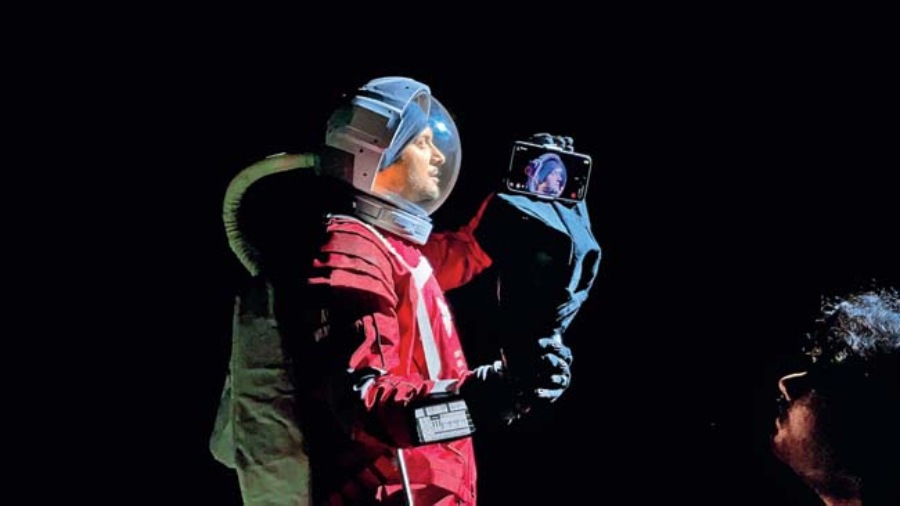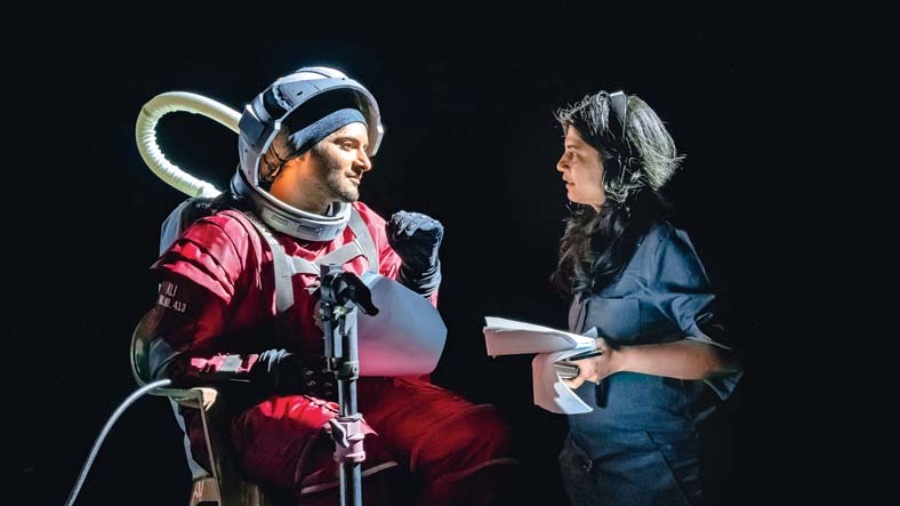In the last few weeks, many of us felt more connected to the universe as the James Webb Space Telescope offered a slideshow of our previously invisible nascent cosmos. The cosmos is expanding and so is our understanding of the universe, and hopefully — at some level — our appreciation for fellow beings.
Back on earth, a short sci-fi film is turning out to be a conversation starter —The Astronaut and his Parrot, directed by Arati Kadav, whom you may know as the director of the 2019 film, Cargo.
In the short film, an astronaut is adrift in space with oxygen levels not on his side. Death is certain, so he hopes against hope to speak to his daughter one last time, to tell her how much he loves her. But his transmissions go unheard, well, almost, as a parrot at a kiosk of a fortune-teller picks it up. Will the message get to the little girl? Or is it all just a dream?
For Arati, the short film is a dream come true because the story is close to her and features an actor without whom the project would have perhaps remained unmade — Ali Fazal. The entry for Fantasia Festival may also appear as a simple ode to love.
‘A leap of faith’
For Ali, it was a pleasure to work with Arati, since he had heard much about her while filming Mirzapur with Vikrant Massey.
“I have been waiting to work with her. I was shooting Mirzapur and Vikrant (Massey) was working with me. He was also working on Cargo and he spoke about the funky ways in which they were innovating and shooting inside a trailer. I am also a science student, so I am a bit of a geek when it comes to sci-fi and technology. It was a visual treat to watch Cargo. For me it was about jumping into something close to that and the idea being to pull something like that off was quite big. Arati had this beautiful vision, a skeleton that was drafted. I am always up for challenges. Things get boring when you already have a predictive piece laid out for you. If you can visualise the whole thing at one go it kills the magic,” says Ali over a late evening video call.
Working with Arati also helped Ali unlock a fresh approach to filming. The short film has been shot on the iPhone, actually multiple iPhones, which has always fascinated film directors around the world.
Perhaps it didn’t take too many nudges to make Arati take up the challenge because she has always been close to technology and has trained as a computer engineer.
“I had a lot of short stories and this was one of my top titles. Whenever I would share this with a team member or technician, they would say it’s complicated. We are at an age when we can push boundaries and tell a story. I just went for it and did solid prep. We tried to make it convincing and in the whole process, tell a good story. There are many things that made the film come together, one being the usage of iPhones; it brought in the element of experimentation, so everyone was trying to do new things. When Ali came on board, it made everything legitimate. If he had said ‘no’ the film wouldn’t have happened; I wanted someone charismatic. If Ali believes he is in space, the audience will believe the same. If he is convinced that he is talking to a parrot, the audience will be convinced. It’s a tough film to make because it takes a leap of faith when it comes to the narrative,” says the director, who spent her childhood in Nagpur.

The short film The Astronaut and his Parrot has been completely shot on the iPhone
‘Emotions are personal’
The star of films like Victoria & Abdul, Death on the Nile and Mirzapur is used to having large cameras trained on him. Here, it was a set of iPhones but that didn’t change his approach to acting.
“We were in a dark room and it was, at times, even difficult to locate where the phones were. Some two-three iPhones were always rigged up, capturing one version or the other. Arati made it very immersive for me because the story was very personal. Though it’s no comparison, I am reminded of (Christopher) Nolan’s Interstellar. There was a time when Nolan went to Hans Zimmer and while explaining the story, he never told him about the (element of) space. He said it was a father-daughter story and that’s how the entire background score came about. Then you see all the other elements being pieced together,” says Ali.
Arati also pushed him out of his comfort zone: “I remember shooting one of the sequences where we thought we had got it. But Arati said we could push it further. After a long time, I realised that I had become rigid. I assumed we had got the shot. She said to push it further. The film was shot on an iPhone (vis-a-vis traditional cameras) but the emotions were personal and it’s hopefully as real as possible. My interactions with her made me believe in the world (we created). That’s cinema. You want to imagine and want to bring that imagination to everybody.”

A behind-the-scene moment
‘Hungry to make more sci-fi films’
Sure, shooting a film using the iPhone is on the rise but so is the editing process on MacBook Pro. A few years ago, it was unthinkable to edit a film on a laptop but the Apple device is getting powerful by the day, thanks to the custom-built chipsets.
“I was fortunate to have a MacBook Pro and I edited the film on it. I am an impatient editor, so as soon as I get any footage, I look at it… before it goes through any kind of conversion. I am generally awake all night, wondering if I had got the scene right. It was a good experience for me… intimate in many ways. I shot it on the iPhone with the phone being very close to the actor and then used MacBook… Meanwhile, I had other projects going, so I had all the footage and worked round the clock. That way it was an intimate experience. For the first time I felt that film-making had become truly democratic in a way,” says Arati.
In fact, earlier there was no way one could shoot something like this without a massive studio support. Even to do VFX of a film like this, people wouldn’t know where to start or the machines that would be required in the process. “It took a long time to render. Here it was very fast and thus a breakthrough. The film has made me hungrier to make sci-fi films,” she says.
The Ali-Arati team is also a perfect combination when it comes to sci-fi because both have a soft corner for the genre.
“I grew up in Nagpur in a very middle-class setting. My early exposure to sci-fi was through comics, like the Mahabharata. That was my early access to fantasy/sci-fi. Then I moved on to Ray Bradbury of whom I am a huge fan. Ursula K. Le Guin is also my favourite. Off late, I am consuming eastern sci-fi. I love Ted Chiang, Liu Cixin… I am appreciating that,” says Arati.
Ali quickly chimes in with is favourites. “I have been a big fan of Space Odyssey. I recently watched something very interesting, not very sci-fi but brings everything together It’s called Everything Everywhere All at Once. It’s a mother-daughter story and I hope everyone gets to watch it. The fascination with sci-fi is that it’s been about the unknown… the other side of the world. Even our body’s molecules and cells behave in the same way as many multiple universes do. That part is fascinating. I come from a spiritual side… there’s so much to what we have known physically. It’s just that fascination about what lies there, which is also an interesting blueprint of what lies within. That will never cease to exist… the fascination.”
Anyone following the exploits of the James Webb Space Telescope will understand the fascination Ali is talking about. How did the universe evolve? Are we not alone? While the low-key big win for science continues so do the milestones that are being notched up by The Astronaut and his Parrot.
